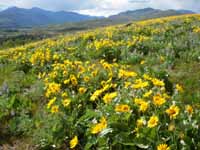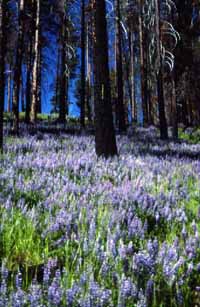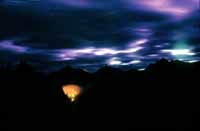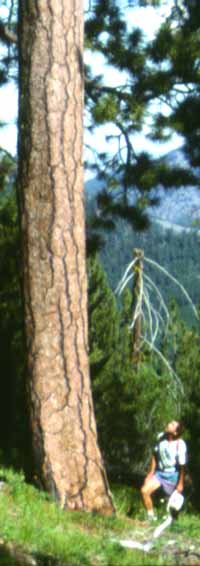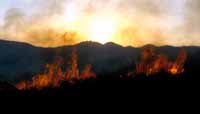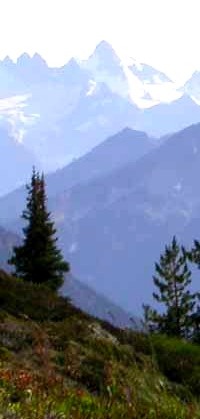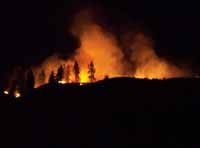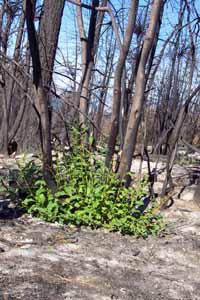Resources about fire: experts and links
Experts at Pacific Biodiversity Institute
Peter Morrison, ecologist and Executive Director
Peter has a broad background in ecology and landscape analysis. He has studied the fire history and ecology of western United States landscapes for over 20 years. He is the author of several papers and reports on fire history and wildfire assessments. Prior to founding Pacific Biodiversity Institute, he worked at the Sierra Biodiversity Institute, the Wilderness Society, the US Forest Service, and at Oregon State University.
Experts at Universities
William Baker, University of Wyoming
Dr. William L. Baker is an ecology professor in the Department of Geography and Recreation at the University of Wyoming, Laramie. His specialty is landscape ecology of large disturbances (fire, floods) in the Rocky Mountains. He is the author of recent book chapters on Indians and fire in the Rocky Mountains and on fire and climate in the Rocky Mountains. Current research is on fire history and ecology in Rocky Mountain National Park, Colorado, and the Medicine Bow Mountains in Wyoming.
Phone: 307-766-2925
Penelope Morgan, University of Idaho
Dr. Penelope Morgan is a professor in the College of Natural Resources at the University of Idaho. She teaches, conducts research, and co-directs the Natural Resources Ecology and Conservation Biology Program. For more than 20 years, she have been involved in forest and natural resource management in the West. Most of her involvement is through teaching and research in ecology, especially fire ecology and landscape ecology. She was born and raised in the West, and have never lived far from the spine of the Rocky Mountains. In recent research projects, she has investigated the linkages of fire, vegetation and climate across multiple temporal and spatial scales in Rocky Mountain Wilderness areas, evaluated the ecological effects and role of fire in whitebark pine forest ecosystems, mapped changing fire regimes, and focused on restoration ecology. she has worked in ponderosa pine and mixed conifer forests, subalpine forests at high elevation, and warm, mesic forests supporting western white pine in northern Idaho.
email: pmorgan@uidaho.edu
Thomas Swetnam, University of Arizona
Dr. Thomas Swetnam is Director, Laboratory of Tree-Ring Research, University of Arizona. He is professor of dendrochronology, Laboratory of Tree-Ring Research and holds joint professorial appointments in School of Renewable Natural Resources and Ecology and Evolutionary Biology as well as an adjunct appointment in Geography and Regional Development.
Dr. Swetnam studies disturbances and the effects of climate change on forest ecosystems. He uses dendrochronology (tree rings) in combination with other natural archives and documentary sources to reconstruct the histories of fire, insect outbreaks, human land uses, and climate. His work has included the study of El Nino-Southern Oscillation and forest fire activity in the Southwest U.S., fire regime and climate changes in giant sequoia groves of the Sierra Nevada, and the history and dynamics of forest insect outbreaks in the western U.S. Dr. Swetnam and his collaborators are currently studying disturbance and climate histories in northern Mexico, the Northern Rockies of Idaho and Montana, Blue Mountains of Oregon, Southern Rockies in Colorado, Patagonia region of Argentina, and the Central Plateau of Siberia, Russia.
Dr. Thomas W. Swetnam, Director and Professor of Dendrochronology
Laboratory of Tree-Ring Research
University of Arizona
Tucson, AZ 85721
(520) 621-2112 office
(520) 621-8229 fax
tswetnam@ltrr.arizona.edu
Experts at government organizations
Jon E. Keeley U.S. Geological Survey, stationed at Sequoia National Park
Dr. Keeley earned his Ph.D. in botany and ecology from the University of Georgia in 1977 and has a Master’s degree in biology from San Diego State University. He is currently a research ecologist with the U.S. Geological Survey, stationed at Sequoia National Park and holds an adjunct position as professor of Organismic Biology, Ecology and Evolution at the University of California, Los Angeles. In 1997-98 he served 1 year in Washington, D.C. as director of the ecology program for the National Science Foundation. Prior to this he was professor of biology at Occidental College for 20 years and spent a sabbatical year at the University of Cape Town, South Africa. He has over 190 publications in national and international scientific journals and books. His research has focused on ecological impacts of wildfires as well as other aspects of plant ecology, including rare plants, rare habitats such as vernal pools, and plant physiology. In 1985 he was awarded a Guggenheim Fellowship and is a Fellow of the Southern California Academy of Sciences and an Honorary Lifetime Member of the California Botanical Society. He has served on the Los Angeles County Department of Regional Planning Environmental Review Board, the State of California Natural Communities Conservation Program (NCCP) Board of Scientific Advisors.
Jon E. Keeley, Station Leader
U.S. Geological Survey
Western Ecological Research Center
Sequoia-Kings Canyon Field Station
47050 Generals Highway
Three Rivers, CA 93271-9651
Michael Murray is a terrestrial ecologist at Crater Lake National Park
Dr. Michael Murray is an experienced fire ecologist with positions including Ecologist with the Oregon Natural Heritage Program, Fire Effects Monitor for Redwood National Park, Fire Ecology Instructor for the University of Idaho, and Spruce Bark Beetle Analyst for Wrangell-St. Elias National Park in Alaska. Dr. Murray is an expert in high-elevation fires and has published studies from the Northern Rocky Mountains. He continues to document impacts of fire suppression on fire-dependent ecosystems and advocates the replacement of the Smokey Bear symbol with an alternate, more truthful representation of fire’s role in sustaining wildlife habitat.
Michael Murray, Terrestrial Ecologist
Crater Lake National Park
PO Box 7
Crater Lake, OR 97604
541-594-3072 , Fax:594-3070
Experts at other organizations
Timothy Ingalsbee, Ph.D., is director of the Western Fire Ecology Center for the American Lands Alliance. The Western Fire Ecology Center does research, analysis, education, and advocacy on fire-related federal forest management issues. Timothy earned a Ph.D. in environmental sociology from the University of Oregon, and has taught courses on the social aspects of fire management and fire ecology restoration at Willamette Univ., Humboldt State Univ., and the Univ. of Oregon. Timothy was a wildland firefighter for the US Forest Service and National Park Service, and is a frequent speaker and writer on federal fire management issues. Timothy received the Oregon Conservationist of the Year Award in 1993 for his work educating the public about wildland fire ecology, and developing a Fire Process Research Natural Area proposal for the Warner Creek Fire area.
Timothy Ingalsbee, Ph.D.
Director, Western Fire Ecology Center
P.O.B. 51026, Eugene, OR 97405
(541) 302-6218
Fire links
Below are links to the wildfire websites that we have found to be most helpful.
US GOVERNMENT SITES
- National Interagency Fire Center
- Geospatial Multi-Agency Coordination Group (GEOMAC) - map and thermal images of all US fires
- USFS Fire Information Directory
- National Incident Information Center
- Archive of Incident Management Reports (Center for International Disaster Information)
- Northwest Interagency Coordination Center - info on Northwest fires and links to many other sites
- Wildland Fire Information Sources - links page
- Bureau of Indian Affairs Interagency Fire Center
- Bureau of Land Management Wildfire Information
- Wildland Fire in Yellowstone National Park
STATE GOVERNMENT SITES
WILDFIRE MEDIA LINKS
CONSERVATION ORGANIZATIONS WORKING ON WILDFIRE ISSUES
Copyright © 2009 Pacific Biodiversity Institute
PO Box 298, 517 Lufkin Lane
Winthrop, WA 98862 509-996-2490
